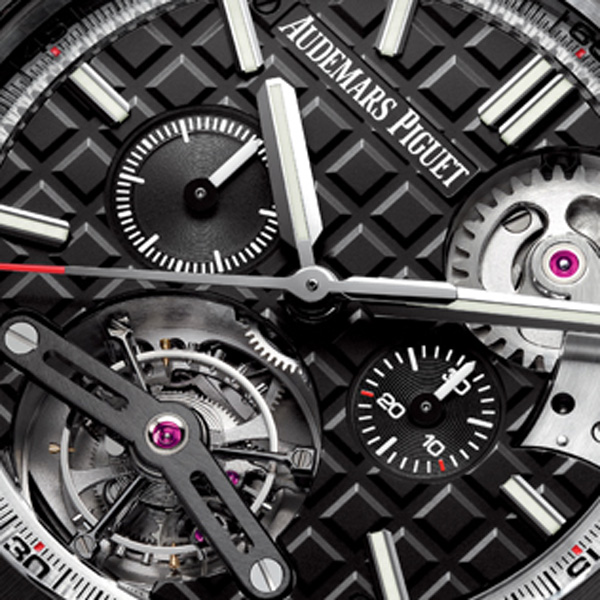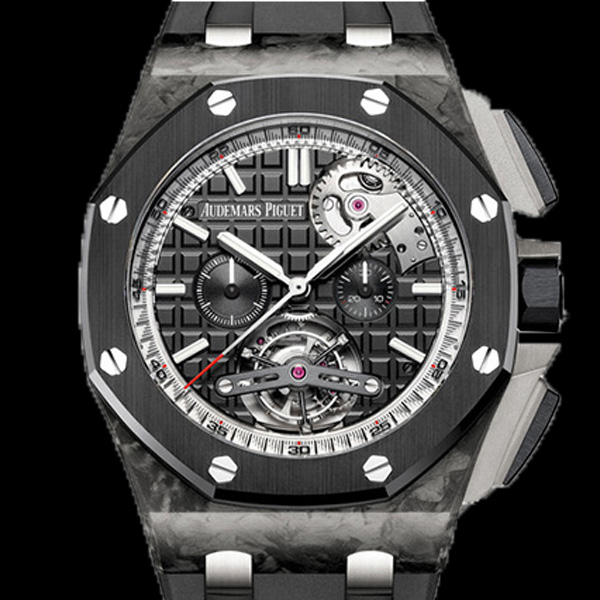AN EXCEPTIONAL BLEND OF TRADITIONAL WATCH MAKING SAVOIR FAIRE AND HIGH TECH THINKING
It was in 1993 that Audemars Piguet established a whole new category of sports watch with the ground-breaking Royal Oak Offshore. A natural evolution of the original, octagonal Royal Oak which took the watch world by storm in 1972, the supersized 'Offshore' was large, bold, rugged and highly functional.
The thinking behind the design of its 42mm diameter case was to create a luxury sports watch which was virtually indestructible. A soft iron inner cage made it ultra-resistant to magnetism; a rubber coated crown and pushpieces combined with a visible gasket beneath the screwed-down bezel made the watch exceptionally waterproof - and the sheer volume of metal in the case provided the selfwinding movement with an unparalleled degree of protection.
It was not long before the Royal Oak Offshore attracted a cult following among horological aficionados, leading to its current status as one of the all-time greats of modern watch making which has been interpreted in numerous different configurations yet which has always retained its essential, original character.
One of the most dramatic and unexpected of those interpretations appeared in 2010 in the form of the first Royal Oak Offshore Tourbillon Chronograph featuring a hand-wound movement and a case incorporating forged carbon and ceramic.
Now, four years later, Audemars Piguet is proud to present an entirely new Royal Oak Offshore Tourbillon Chronograph driven by the very latest, selfwinding Calibre 2897 which has been especially developed to power it.
As mighty as the watch itself, the Calibre 2897 mechanism comprises 335 parts and can be seen in all its glory through a sapphire crystal caseback. A true, micro mechanical work of art, the movement is rich in components which have been bevelled, polished, chamfered and decorated entirely by hand to create a shimmering play of light and shade.
From an engineering perspective, too, the Calibre 2897 stands out: the automatic winding system is driven by a peripheral oscillating weight made from satin-brushed, 950 platinum. The calibre can be seen through a special aperture at the one o’clock position as well as through the oscillating weight visible from the dial side.
Exceptional accuracy is ensured, meanwhile, through both the tourbillon mechanism and the use of the column wheel system, which is widely regarded as being the most reliable and precise of all chronograph configurations.
To protect this sublimely beautiful powerhouse, Audemars Piguet's designers have created a very special version of the Royal Oak Offshore case based on modern, black coloured materials: forged carbon for the middle,ceramic for the bezel, titanium and ceramic for the push pieces and rubber for the strap.
The Royal Oak Offshore Selfwinding Tourbillon Chronograph: an exceptional blend of traditional watch making savoir faire and high tech thinking.
A MOVEMENT DESIGNED, DEVELOPED AND CREATED ENTIRELY IN-HOUSE
The Calibre 2897 movement was created entirely in-house by Audemars Piguet using the very latest in horological technology combined with the classic watch making skills for which the company has been renowned since its founding almost 140 years ago.
Everything from the rounded cut of the bridges to the S-shaped coupling yoke (traditional to the watch making of the Vallée de Joux), the curves of the minute-counter bridge and the characteristic toothing of the column wheel display a mechanical artistry that almost belies the fact that the finished article is a precision mechanism capable of slicing time in to fragments of a second.
Audemars Piguet is one of the few remaining high-end watch makers to still use such a high level of decoration, which includes classic finishes such as mirror polishing, hand chamfering, circular graining and hand-drawing.
All of these are executed manually in a series of meticulous operations that account for as much as 30 per cent of the value of the finished timepiece.
The process takes many hundreds of hours before the master watch maker can perform an initial trial assembly in order to give first life to the newly created Calibre 2897 movement - after which everything is dismantled, meticulously cleaned and made ready for final assembly before being mounted in the 44mm Royal Oak Offshore case.
THE PERIPHERAL OSCILLATING WEIGHT - AN ELEGANT SOLUTION
The automatic winding mechanism of the new Royal Oak Offshore Selfwinding Tourbillon Chronograph is driven by a peripheral oscillating weight made from 950 platinum and mounted on ball bearings, a design which shifts the mass of the rotor to the outer edge of the movement where it improves winding speed and, therefore, efficiency.
The size of the 180 degree oscillating weight has been specifically optimized, and the centre of the case recessed in order to allow the weight to rotate a full 360 degrees. Its position on the edge of the movement means the overall thickness of the watch is not increased, making for both a slimmer overall profile and allowing the exceptional chronograph mechanism to be clearly viewed through the sapphire crystal case back.
THE TOURBILLON - THE MOST ENTRANCING OF ALL HOROLOGICAL DEVICES
The tourbillon has long been considered the apotheosis of the watch maker's art and, although it was invented as long ago as the late 18th century, few makers today have the capability to create their own. One of the select few to have mastered the art is Audemars Piguet which has debuted more than 16 tourbillon-equipped movements and, in 1986, became the first maker to offer an ultra-thin, selfwinding tourbillon wrist watch.
Designed to counter the effect of gravity on timekeeping, the tourbillon houses the escapement (the regulating organ of the watch) within a tiny, revolving carriage that spins on its axis once every minute, thus preventing the hairspring from remaining static and thus enhancing accuracy.
The tourbillon contained within the Royal Oak Offshore Selfwinding Tourbillon Chronograph brings this historic device right in to the 21st century by way of a blackened, titanium bridge. It takes a master watch maker almost three days to assemble the tourbillon carriage, which comprises 85 parts yet weighs a mere 0.45 grammes.
THE CHRONOGRAPH - A CONSTANTLY PERFECTED MECHANISM
Audemars Piguet is therefore a master of the chronograph - as seen in the fact that the firm's oldest piece in its heritage collection is an 1881 'foudroyante' version.
Over the centuries, it has consistently introduced solutions to the problems of chronograph design, making one of the smallest chronograph calibre in the form of a 22.5 mm model from 1886 and producing its first chronograph wrist watch as early as the 1920’s.
This long experience manifests itself in the instantly visible column wheel of the Calibre 2897 movement, which marks it out as being one of the finest mechanisms of its type and serves to perfectly co-ordinate the start, stop and re-set phases.
Observers of the complication in action will notice the perfect smoothness with which the chronograph hand takes off when timing begins - a result of the specially-developed coupling yoke principle which has been designed to eliminate the characteristic jerkiness of less efficient mechanisms.
Audemars Piguet's engineers have further refined the system by adding a shock-resisting hook. Meticulous hand assembly and adjustment of the chronograph components further enhance its smooth functionality by providing the pushpieces with an exceptional degree of 'feel'.
THE INIMITABLE DESIGN OF THE ROYAL OAK OFFSHORE COLLECTION
Few watches are as instantly recognisable as the Royal Oak Offshore - or as synonymous with a sporting, rugged lifestyle. On this version, connoisseurs of the Royal Oak Offshore will find the model's eight, trademark polished steel hexagonal screws nestling within the recesses of a black ceramic bezel, which has contrasting satin brushed and polished surfaces to provide exceptional definition of its clean-cut angles.
The powerful case middle is constructed from forged carbon - a material that was first brought to watch making from the aerospace industry by Audemars Piguet in the original Royal Oak Offshore back in 2007.
The pushpieces, meanwhile, are made from ceramic and titanium and set within separate, titanium guards which are secured to the main body of the case by four visible screws.
The dial of the Royal Oak Offshore Selfwinding Tourbillon Chronograph will also be familiar to aficionados of the range, being decorated with the established 'Mega Tapisserie' motif - and left open at the six o'clock position to provide a clear view of the tourbillon.
The Royal Oak Offshore Selfwinding Tourbillon Chronograph to be launched at the Watches & Wonders fair in Hong Kong, will be produced in a numbered series of 50 pieces.







You do not have access to view this Atom.
ROYAL OAK OFFSHORE SELFWINDING TOURBILLON CHRONOGRAPH
Limited Edition of 50
Reference: 26550AU.OO.A002CA.01
MOVEMENT
Selfwinding Calibre 2897with tourbillon and column-wheel chronograph
Total diameter : 35mm (15½ lignes)
Total thickness : 8.32 mm
Number of jewels : 34
Number of parts : 335
Minimal guaranteed power reserve : > 65 h
Frequency of balance wheel : 3 Hz (21,600 vibrations / hour)
Variable-inertia balance with screws and balance-spring with Phillips terminal curve
Finishing: all parts finely hand decorated; bridges and mainplate rhodiumed, circular-grained, beadblasted and hand-drawn with file strokes; polished angles, bevelled screw rims and slots
Peripheral oscillating weight in circular satin-brushed 950 platinum
CASE
Forged carbon case, glareproofed sapphire crystal caseback with Royal Oak Offshore engraving, black ceramic bezel, crown and pushpieces, titanium pushpiece guards.
Diameter : 44 mm
Thickness : 14 mm
DIAL
Black dial with “Méga Tapisserie” pattern, black counters, gold applied hour-markers and gold Royal Oak hands with luminescent coating. Sapphire inner ring.
STRAP
Black rubber with titanium pin buckle
FUNCTIONS
Hours and minutes
Small seconds at 9 o’clock
Chronograph with central sweep-seconds hand, 30-minute counter (at 3 o’clock)




